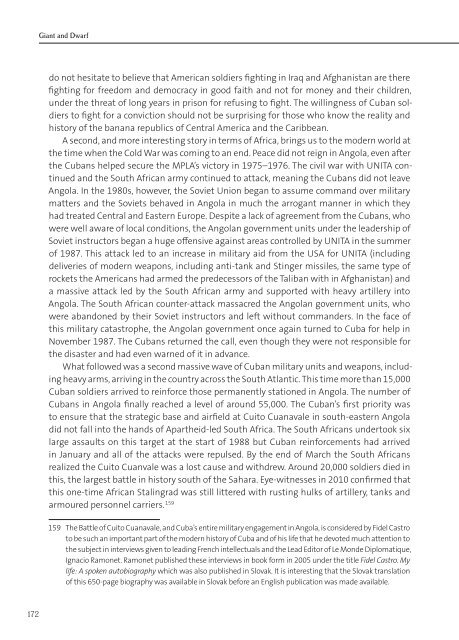Giant_and_Dwarf-FIN
Giant_and_Dwarf-FIN
Giant_and_Dwarf-FIN
Create successful ePaper yourself
Turn your PDF publications into a flip-book with our unique Google optimized e-Paper software.
<strong>Giant</strong> <strong>and</strong> <strong>Dwarf</strong>do not hesitate to believe that American soldiers fighting in Iraq <strong>and</strong> Afghanistan are therefighting for freedom <strong>and</strong> democracy in good faith <strong>and</strong> not for money <strong>and</strong> their children,under the threat of long years in prison for refusing to fight. The willingness of Cuban soldiersto fight for a conviction should not be surprising for those who know the reality <strong>and</strong>history of the banana republics of Central America <strong>and</strong> the Caribbean.A second, <strong>and</strong> more interesting story in terms of Africa, brings us to the modern world atthe time when the Cold War was coming to an end. Peace did not reign in Angola, even afterthe Cubans helped secure the MPLA’s victory in 1975–1976. The civil war with UNITA continued<strong>and</strong> the South African army continued to attack, meaning the Cubans did not leaveAngola. In the 1980s, however, the Soviet Union began to assume comm<strong>and</strong> over militarymatters <strong>and</strong> the Soviets behaved in Angola in much the arrogant manner in which theyhad treated Central <strong>and</strong> Eastern Europe. Despite a lack of agreement from the Cubans, whowere well aware of local conditions, the Angolan government units under the leadership ofSoviet instructors began a huge offensive against areas controlled by UNITA in the summerof 1987. This attack led to an increase in military aid from the USA for UNITA (includingdeliveries of modern weapons, including anti-tank <strong>and</strong> Stinger missiles, the same type ofrockets the Americans had armed the predecessors of the Taliban with in Afghanistan) <strong>and</strong>a massive attack led by the South African army <strong>and</strong> supported with heavy artillery intoAngola. The South African counter-attack massacred the Angolan government units, whowere ab<strong>and</strong>oned by their Soviet instructors <strong>and</strong> left without comm<strong>and</strong>ers. In the face ofthis military catastrophe, the Angolan government once again turned to Cuba for help inNovember 1987. The Cubans returned the call, even though they were not responsible forthe disaster <strong>and</strong> had even warned of it in advance.What followed was a second massive wave of Cuban military units <strong>and</strong> weapons, includingheavy arms, arriving in the country across the South Atlantic. This time more than 15,000Cuban soldiers arrived to reinforce those permanently stationed in Angola. The number ofCubans in Angola finally reached a level of around 55,000. The Cuban’s first priority wasto ensure that the strategic base <strong>and</strong> airfield at Cuito Cuanavale in south-eastern Angoladid not fall into the h<strong>and</strong>s of Apartheid-led South Africa. The South Africans undertook sixlarge assaults on this target at the start of 1988 but Cuban reinforcements had arrivedin January <strong>and</strong> all of the attacks were repulsed. By the end of March the South Africansrealized the Cuito Cuanvale was a lost cause <strong>and</strong> withdrew. Around 20,000 soldiers died inthis, the largest battle in history south of the Sahara. Eye-witnesses in 2010 confirmed thatthis one-time African Stalingrad was still littered with rusting hulks of artillery, tanks <strong>and</strong>armoured personnel carriers. 159159 The Battle of Cuito Cuanavale, <strong>and</strong> Cuba’s entire military engagement in Angola, is considered by Fidel Castroto be such an important part of the modern history of Cuba <strong>and</strong> of his life that he devoted much attention tothe subject in interviews given to leading French intellectuals <strong>and</strong> the Lead Editor of Le Monde Diplomatique,Ignacio Ramonet. Ramonet published these interviews in book form in 2005 under the title Fidel Castro. Mylife: A spoken autobiography which was also published in Slovak. It is interesting that the Slovak translationof this 650-page biography was available in Slovak before an English publication was made available.172


